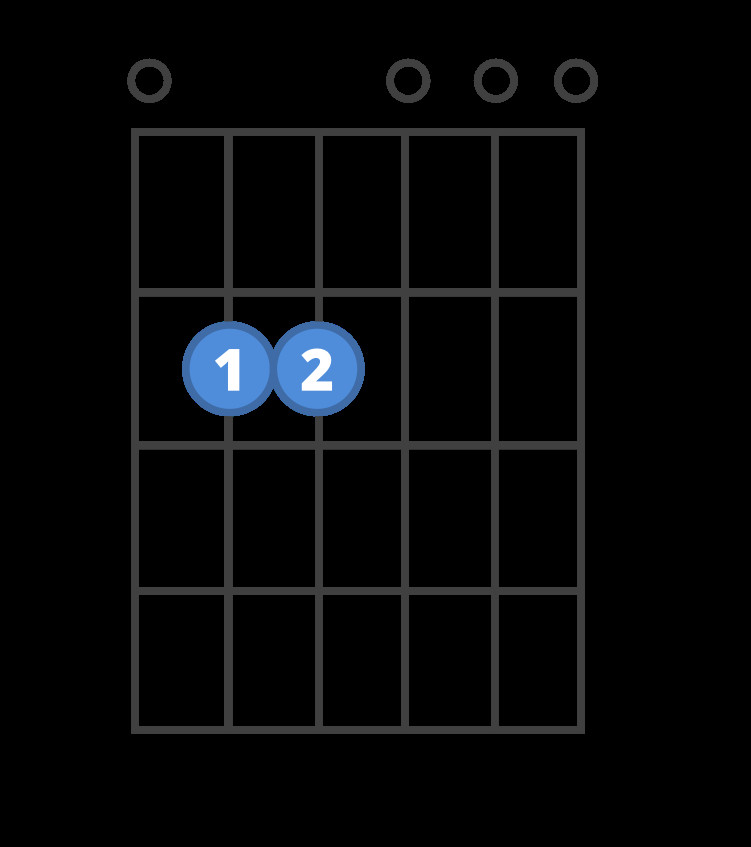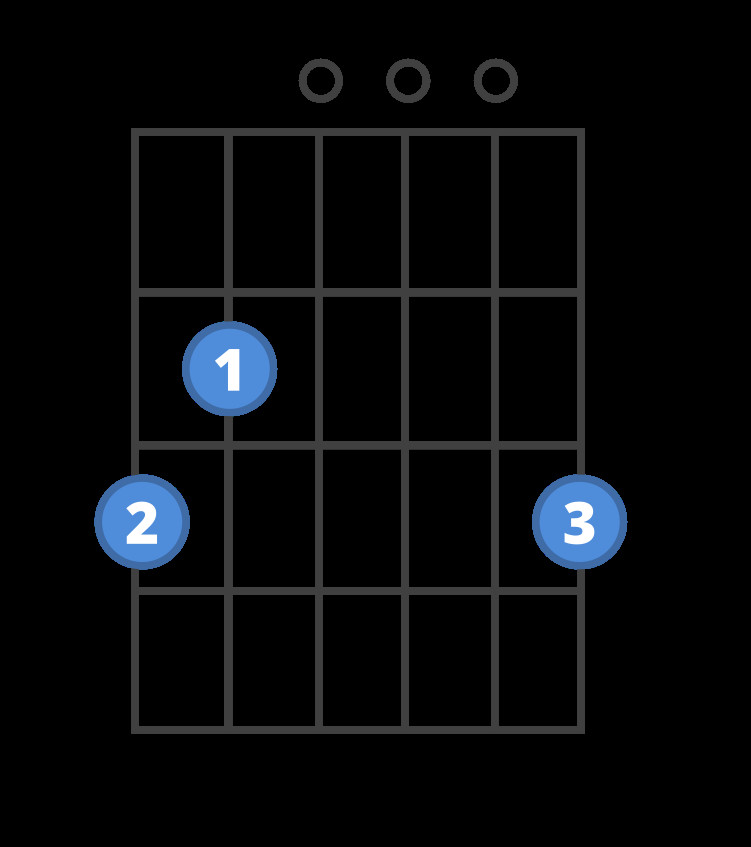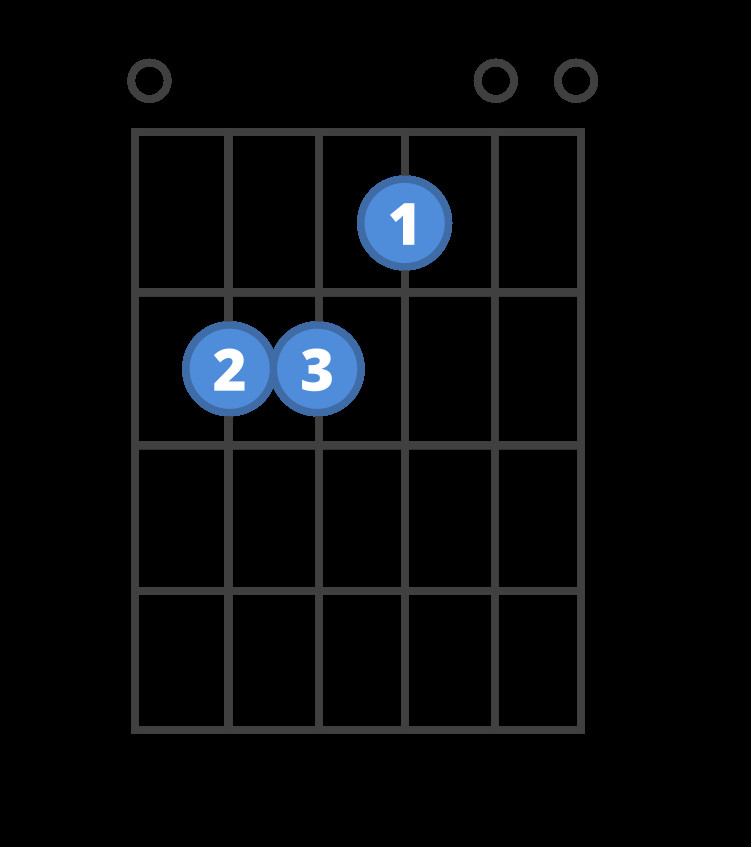The E minor chord (often written as Em) is a foundational chord for guitarists of all levels. It’s known for its melancholic yet beautiful sound, and thankfully, it’s also one of the easiest chords to learn on the guitar. This guide will break down how to play the Em chord, offer practice tips, and show you why it’s such an essential part of your guitar journey.
 Chord diagram for the Em guitar chord.
Chord diagram for the Em guitar chord.
Getting Your Fingers in Position: How to Play Em
The E minor chord is a two-finger chord, making it a great starting point for beginners. Here’s a simple step-by-step method to get your fingers in the correct position:
- Find the Second Fret: Locate the second fret on your guitar’s neck. This is the metal bar two frets away from the headstock.
- Second Finger on the A String: Place your second finger (middle finger) on the 5th string (A string) at the second fret. Press down just behind the fret, ensuring the string rings clearly.
- Third Finger on the D String: Now, place your third finger (ring finger) on the 4th string (D string) at the second fret. Again, make sure your finger is just behind the fret for a clean sound.
- Strum All Six Strings: Using a pick or your thumb, strum all six strings downwards. You should hear the full, resonant sound of the E minor chord.
Many beginners wonder if they can use their first and second fingers instead. While technically possible, using your second and third fingers is generally recommended. This fingering leaves your first finger free to transition to other common chords like C major, A minor, or D major more smoothly, which you’ll encounter frequently in songs.
Why is the E Minor Chord Important?
The Em chord isn’t just easy to play; it’s incredibly versatile and widely used in countless songs across genres. From classic rock to folk and pop, the E minor chord provides a rich, emotional depth. Learning Em opens up a vast repertoire of songs and allows you to explore the world of minor keys in music.
Knowing the E minor chord is your gateway to understanding minor scales and how minor chords function within song structures. It’s a stepping stone to more complex musical concepts, but it’s also immediately rewarding as you can start playing real songs quickly.
Practice Techniques to Master the Em Chord
Consistent practice is key to making the Em chord sound effortless. Here are some effective practice techniques:
The On-Off Drill: This drill is fantastic for building muscle memory and improving finger placement speed and accuracy.
- Place your fingers: Position your fingers correctly for the Em chord.
- Strum and Count: Strum the chord for four beats, counting aloud (1, 2, 3, 4).
- Lift Fingers Off: Remove your fingers from the strings for another four beats, keeping the rhythm in your mind.
- Repeat: Immediately place your fingers back into the Em chord position and repeat the strumming and lifting cycle.
This on-off repetition helps your brain and fingers memorize the shape and position of the Em chord.
Chord Switching Practice: Once you’re comfortable with the on-off drill, start practicing switching between Em and other chords. Good chords to practice switching with are:
- G Major: A common chord paired with Em.
- C Major: Another frequently used chord in combination with Em.
- D Major: Creates a classic and popular chord progression with Em and G.
- A Minor: A related minor chord that complements Em well.
Practice switching smoothly between these chords, focusing on minimizing the time it takes to change chords while maintaining a steady rhythm.
 Chord diagram for the G guitar chord.
Chord diagram for the G guitar chord.
E Minor vs. E Major: Understanding the Difference
If you’re already familiar with the E major chord, you’re in luck! The E minor chord is very closely related, with only a single finger position difference.
The distinction between major and minor chords comes down to music theory, specifically the third interval. In simple terms, a minor chord has a “flatter” or “smaller” third compared to a major chord.
Visually, when comparing the chord diagrams:
Em (E minor)
 Chord diagram for the Em guitar chord.
Chord diagram for the Em guitar chord.
E (E Major)
 Chord diagram for the E guitar chord.
Chord diagram for the E guitar chord.
You can see that the E major chord (on the right) adds an extra finger on the G string (3rd string) at the first fret. This note raises the third of the chord, changing it from minor to major. While understanding the theory is helpful, for now, just remember the slight finger position difference to switch between E major and E minor.
Play Along and Expand Your Chord Vocabulary
Once you can confidently play the Em chord and switch between a few other chords, start playing along with songs! Many beginner guitar songs utilize the Em, G, C, and D chord progression. Playing along with music is not only fun but also a fantastic way to improve your timing and chord transitions.
As you progress, explore other easy minor chords like A minor (Am) and D minor (Dm). Expanding your vocabulary of minor chords will enhance your musicality and allow you to play a wider range of songs.
Learning the E minor chord is a significant step in your guitar journey. Its ease of play and widespread use make it an incredibly valuable chord to master early on. Keep practicing, and soon you’ll be playing songs and enjoying the rich sound of the Em chord!
Explore more chords and expand your guitar skills on guitarplayers.net!
